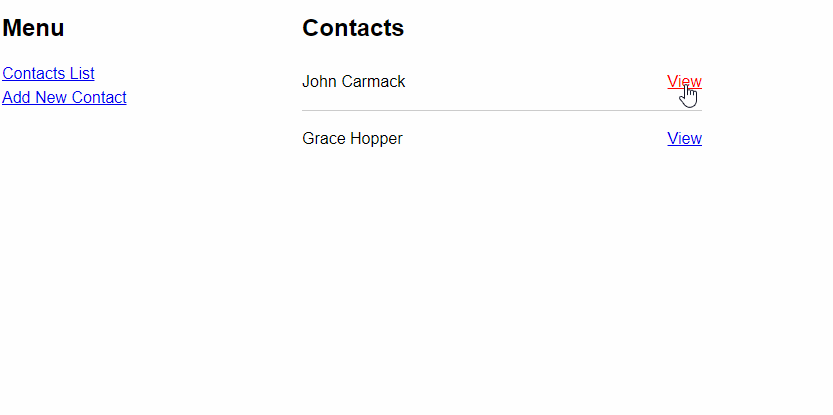In this exercise you are going to practice:
- Fetching data from a server using
useEffectandfetch - Implementing a controlled form
- Posting data to a server using
fetch - Implementing multiple routes
Some of the components have been created for you.
- Fork and clone this repository
npm installnpm start- Start json-server. In a new terminal:
npx json-server -p 4000 db/db.json - Visit localhost:4000/contacts to make sure your json-server is running
- A user can view a list of contacts at "/" when the app loads.
- Each contact should show first name and last name
- The list of contacts should be fetched from json-server
- A user can create a contact at "/contacts/add" via a form when the "Add New Contact" menu link is clicked
- The created contact should have:
- first name
- last name
- street
- city
- When the form is submitted, the created contact should be saved in the database by sending to json-server
- The created contact should be also be added to the contacts list
- The add new contact form should be reset
- The created contact should have:
- A user can view a specific contact at "/contacts/:id" by pressing a "view" link from the contacts list
- The view contact page should display all the details of the contact
- The specific contact should be fetched from json-server based on it's id
- Check
db/db.jsonand think about which URLs you are going to need when creating yourfetchfunctions. - Using the instructions above, json-server will run on
localhost:4000, so you canGETall contacts athttp//localhost:4000/contacts. - You can add a new contact by
POST-ing tohttp//localhost:4000/contacts - You can also use a tool such as Insomnia to test these requests before you start writing code
- Add support for defining the following fields for each contact:
- Update the new contact form and the contact view page to show these fields
- The user is automatically returned to the contacts list page when a contact is added.
- Take a look at
useNavigateon React Router for how to do this.
- Take a look at
- A user can edit a contact when an "Edit" link is clicked in the contacts list
- The updated contact should be saved in the database using a
PUTorPATCHcall to json-server - The updated contact should be viewable in the contacts list
- The updated contact should be saved in the database using a
- The user can delete a contact from the contacts list
- A user can see a loading spinner when the initial list of contacts is being fetched from json-server
- To test this, you can use Chrome Developer Tools to throttle your network connection
- Note: Your solution should assume that the list of contacts returned from the server could be empty
- A user can view a list of meetings and create new meetings for each contact at "/contact/:id/meetings"
- From the contact view page, a new link should be added, "Meetings" which takes the user to a new page, rendered with a new
Meetingscomponent - When the component loads, a list of meetings arranged for that contact should be fetched from json-server.
- A form at the top of the list should allow the user to add new meetings. Each meeting should contain a date, a time and a location.
- New meetings should be saved using json-server
- From the contact view page, a new link should be added, "Meetings" which takes the user to a new page, rendered with a new
- For this extension you will need to update the
db.jsonfile to store meeting objects. See the json-server documentation for more details. - When fetching meetings from the server, you should load only meetings for that specific contact. You can do this through json-server filters
- When you add meetings, you will need to "link them" to the specific contact by including the contact id in each meeting
- Note although it's possible to embed the meetings array inside the contact object in json-server, the intention of this extension is to practice
useEffectwith a dependency on a prop, so you should represent the meetings as a seperate resource inside json-serer.
- A user can specify a contact type when adding a contact,
WorkorPersonal. - Update the contacts list and contact view to show the contact type. Display each type in a different style, or use conditional rendering to add a different icon or emoji next to the contact based on their type.
- Add filter options to the contacts list so the user can toggle each contact type. Changing the filter should change the displayed contacts.
- Each time the filter changes, the URL should also be updated.
- In this instance, the specific filters should be added as URL Search params. For example, if the user filters by only "personal", the url should be something like
/?type=personal. If the user filters by only "work", then the url should be/?type=work. If the user filters by both types, then the url should be/?type=work&type=personal. If there are no filters in the URL, then all contacts should be shown. - See
useSearchParamson React Router for one approach to this. - Read the documentation carefully on
useSearchParams. It works similar touseState, but the value you get back is an instance of URLSearchParams, not an object as you may expect. - You may want to consider using
useSearchParamsin a small test project first to understand how it works.
- In this instance, the specific filters should be added as URL Search params. For example, if the user filters by only "personal", the url should be something like
